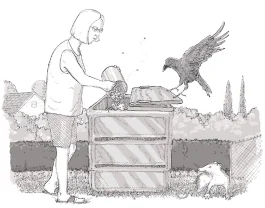My husband, Don, was Christmas shopping one rainy December day when he bumped into a friend who was on his way to the jewelry store to buy his wife a diamond necklace. He asked Don, “What are you buying your wife?”
Slightly embarrassed, my husband replied, “A composter.” His friend snorted, laughed, and continued across the street to the jewelry store. Don entered our local gardening store and bought me a Smith & Hawken black plastic, three-tier composter.
My composter has given me more happiness than any piece of jewelry. I’ve shoveled countless cubic yards of raw materials into its modest square frame, only to be delighted a few months later with fragrant, fluffy, dark brown soil.
The word “compost” is similar to the word “compose,” and I like to think I’m composing something artistic when I build my pile. A maple leaf, for example, with a trace of Fall color, looks nice on top of the remnants of mixed lettuces. I might add a handful of brown-and-white eggshells for a mosaic effect. After the pile is made, I push the compost thermometer through one of the slats and head indoors.
Turning the compost pile, in my opinion, is not a chore but a delight. Here I get to see, and smell, the results of my work. Steam billows from the core, wafting odors into my face: a whiff of coffee grounds, a bit of orange peel, and damp newspaper make a pleasant, stimulating aroma. However, depending on which stage it’s in, my compost might smell like burnt rubber and dirty socks.
I’ve read a lot of books on how to make the best, fastest, hottest compost imaginable. They include detailed recipes that call for precise amounts of “browns” and “greens.” Don’t include any sticks, they warn. Grass clippings can get slimy and smelly, a different book states, so add them in thin layers. Fall leaves must be shredded, says another expert. Yet many things about the compost-ing process remain mysterious. I’ve built precisely calibrated piles that never heated up, while a motley mixture of random materials rose to 170 degrees in a few hours.

My compost never looks like the sanitized, uniform stuff available in sacks at the nursery. It teems with life, some visible, most not. Spiders take up residence in the corners. Earwigs, sow bugs, and earthworms wriggle at the outer edges. I’ve looked at my compost under a magnifying glass and seen the amazing variety of life just out of reach of the naked eye: mysterious round worms, tiny beetles with feathery antennae, red mites, springtails, and gnats. The amount of microbial life in compost is astounding: untold numbers of bacteria, fungi, molds, yeasts, and others populate the pile as it heats and cools.
Larger creatures visit my compost, as well: possums, skunks, mice, rats, and crows have all found tasty morsels there. Once I pulled the lid off and found a kangaroo rat munching on a wilted piece of celery. In spite of my efforts to shoo it away, the rat stayed put until it finished, then lazily climbed out.
After two decades of use, the composter is showing its age. One of our dogs chewed a hole in its side, and years of alternating hot and cold temperatures have warped the plastic, so the lid doesn’t fit anymore. The California sun has faded the original black to a soft gray. But it’s still perfectly functional.
You know, diamonds are pretty useless for gardening. But you can never have too much compost. ❖


 Previous
Previous

